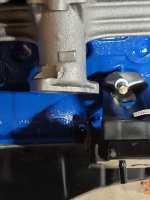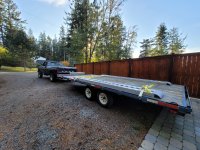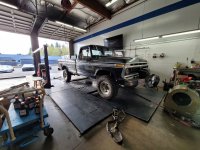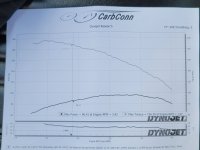For starters, is there much more science behind selecting a throttle body other than not making it excessively large and making sure it's not the smallest diameter restriction on the intake system? In my case, the smallest diameter is the 2" outlet from the turbo and I'll have 2.5" in the intercooler, so it stands to reason I'd be looking around the 60-65 mm range for a throttle body. But I could be off base.
Secondly is more along the lines of intake design theory - My initial idea came from a turbo intake I saw on a 2JZ that wasn't much more than a welded up tube with plates on the ends and runners to the intake flange (first photo below). I started sketching something up that was a similar idea, but instead of having tube runners down, I just have it going straight onto the lower intake. This is based on using a 62mm throttle body, though as I sit here I would probably want 65mm since 62 is smaller than the intercooler piping... but I digress
View attachment 14241
I was trying to think of something that would be easy to fabricate out of simply produced parts, so the manifold flange and TB mount/end cap are just laser cut and welded up to the 4.5" diameter tube.
But back to the more theory question, does TB placement relative to the runners have much of an impact in a turbo build? I.E, is having the air coming in one end of a 28" long manifold going to cause issues with air distribution to the rear cylinders compared to the front? Would there be more benefit to having the throttle body more centrally located on the intake tube?
Keep in mind that post intercooler your charge air becomes more dense. There was an overwhelming trend in the datsun s30 world years back where guys were really eager to put 60mm throttle bodies on their L28's mean while the main intake restriction was the manifold runners. But porting is work and the throttle body was a visible "upgrade" I guess. You should be fine with a 62 or 65mm TB.
Whatever you do for a plenum make sure you have a generous bell mouth radius shape leading into the runners, it helps. Take a look at what plazmaman does for their intakes. Somebody ran some flow models years back (I couldn't find the thread) it showed having the TB angled with a generous short side radius toward the #1 cylinder and the throttle body angled so it kind of points at all the runner ports really helped flow disribution vs the log style intake with the TB mounted 90deg to the runner inlets like your cad model shows.
https://plazmaman.com/product/billet-ba-bf-fg-retro-conversion-manifold/
Also look at the nissan skyline rb20/25 upper intakes. They bolt to the stock lower plenum half just like the stock ford lower you have and are converted to a forward facing TB.
https://plazmaman.com/product/rb25-det-r33-skyline-inlet-plenum/
You can see the distance they put between the TB and first runner. I think some of this is for underhood packaging but it also keeps the air from having to do a hard 90 turn right after getting past the butterfly. How much impact throttle body orientation has on flow in a turbo setup is definitely debatable but the 90deg log definitely was not better than the contoured plenums that guys were testing.








